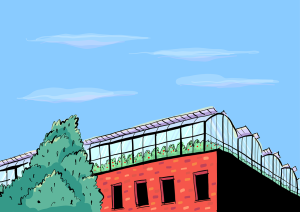
Environment
Farming a changing sea
Struggle and success in Atlantic Canada, where aquaculturists strive to overcome climate change and contamination while chasing a sustainable carbon footprint
- 4058 words
- 17 minutes
This article is over 5 years old and may contain outdated information.
Travel

I must admit: Last month, when my husband and I first decided to take a train from London, England, where we were visiting family, to see some friends in Leeds, I wasn’t expecting much. All I knew about Leeds was that it was a former manufacturing hub in northern England, at one time home to mills and mines — not exactly enticing. Then I started reading up on it, and discovered that Lonely Planet had listed the Yorkshire city among their top 10 cities to visit in Europe in 2017, noting it had “shrugged off its industrial past.” I began to get excited, perhaps sensing that Leeds was about to prove to me just how wrong stereotypes can be.
From the moment we step off the train (Leeds is only about a two-hour journey from London’s King’s Cross station), we’re wowed. It’s a Thursday afternoon and the streets are packed, and though many of the buildings date from the Victorian era, the crowd is decidedly young and hip. (Leeds, with a population of about 760,000, is home to several universities.) We drop our bags off at the Leeds Marriott Hotel, located steps from the rail station on Boar Lane, one of central Leeds’ top streets for nightlife, and make our way along the curving streets and across the Aire River. Our lunch destination is The Tetley, a 1931 building originally used as the headquarters of Tetley brewery (its signature product, Tetley’s English Ale, has been around since 1822 and is ubiquitous in Yorkshire). It’s now a contemporary art gallery complex that we’ve heard has an excellent cafe. It doesn’t disappoint; Tetley Bar & Kitchen offers fresh and delicious selections (I have the rare-tuna salad; my husband goes for the fresh pea risotto), accompanied, of course, by delicious pints of Tetley’s English Ale.

After the meal, we stroll back through the bricked lanes, past independent coffee shops, and over the Aire again to take in Trinity Leeds. This four-year-old shopping centre boasts a unique architectural design: while it’s open air, all 120 shops and 40 eateries are protected by an iconic glass dome. Today, the sky is blue through the glass—but on a rainy day, how cool would it be to go shopping “outdoors” while sheltered from the elements? A giant metal sculpture of a packhorse carrying a roll of cloth reminds visitors of Leeds’ history as major centre for the wool and textile industries.
Later, at the Marriott, I get chatting with 24-year-old Lyneese Freeman, a warm and friendly front desk receptionist with a rich Yorkshire accent. (The Leeds Marriott, by the way, gets top marks: it has amazing staff and impeccable service, and the rooms are bright, refined and comfortable.) Lyneese was born in Leeds and has lived here all her life. I ask her what’s new and exciting about her hometown. “Leeds is more vibrant and lively now than ever,” she says. “There’s lots more to attract and entertain students, but also young professionals—Leeds Trinity, Victoria Gate, the casino, and a lot more. There’s a new, good vibe.” She says it reminds her of the type of revival Manchester experienced a few years back and is still enjoying.

Are you passionate about Canadian geography?
You can support Canadian Geographic in 3 ways:

Environment
Struggle and success in Atlantic Canada, where aquaculturists strive to overcome climate change and contamination while chasing a sustainable carbon footprint

Environment
Already gaining steam before the pandemic, interest in urban farming — and hunger for hyper-local food — has soared. A look at three Canadian takes on the urban farming phenomenon

Travel
Where to stay, what to do and how to make the most out of your time in Costa Navarino

People & Culture
In her new book Feasting Wild: In Search of the Last Untamed Food, geographer and anthropologist Gina Rae La Cerva explores the loss of biodiversity and connection to nature that has resulted from the commercialization of food